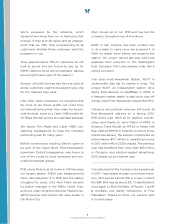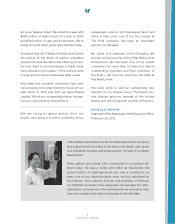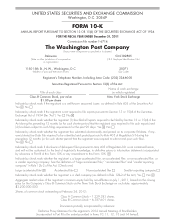Washington Post 2011 Annual Report Download - page 18
Download and view the complete annual report
Please find page 18 of the 2011 Washington Post annual report below. You can navigate through the pages in the report by either clicking on the pages listed below, or by using the keyword search tool below to find specific information within the annual report.Federal student aid, and the institution would not be able to reestablish the program’s eligibility for at least three years,
though the program could continue to operate without student aid. The final rule is scheduled to go into effect on July 1,
2012. However, the first final debt measures will not be released until 2013, and a program cannot lose eligibility until
2015.
Based on current information, the Company does not expect the regulations to adversely impact most of Kaplan’s current
programs. However, some of the data needed to compute program eligibility under this regulation, including graduate
incomes, are not readily accessible to the institutions, but are compiled by the DOE. In addition, the continuing eligibility
of programs for Title IV funding may be affected by factors beyond Kaplan’s control, such as changes in the actual or
deemed income level of its graduates, changes in student borrowing levels, increases in interest rates, changes in the
U.S. Federal poverty income level relevant for calculating the discretionary income test, changes in the percentage of
former students who are current in repayment of their student loans, and other factors.
Incentive Compensation. Under the incentive compensation rule, an institution participating in Title IV programs may not
provide any commission, bonus or other incentive payment based directly or indirectly on success in securing enrollments
or financial aid to any person or entity engaged in any student recruiting or admission activities or in making decisions
regarding the awarding of Title IV funds. The DOE released new rules in October 2010 that went into effect on July 1,
2011. These rules included changes to the incentive compensation rule that reduced the scope of permissible payments
under the rule and expanded the scope of payments and employees subject to the rule. In March 2011, the DOE issued
a “Dear Colleague Letter,” providing guidance on these new rules. The Company has taken steps to fully comply with
these rules and the guidance. Among the actions taken, the Company has revised its compensation plans for admissions
personnel and completely eliminated enrollment results as a component in the determination of compensation. The
Company believes this change in Kaplan’s approach to recruiting adversely impacts its enrollment rates and operating
costs. Kaplan cannot predict how the DOE will interpret and enforce all aspects of the revised incentive compensation
rule in the future and is presently unable to predict the full effect the new rule will ultimately have on the results of KHE.
The 90/10 Rule. Prior to the enactment of the HEOA, any for-profit postsecondary institution (a category that includes
all of the schools in KHE) would lose its Title IV eligibility for at least one year if more than 90% of the institution’s receipts
for any fiscal year were derived from Title IV programs, as calculated on a cash basis in accordance with the Higher
Education Act and applicable DOE regulations. Under amendments to the Higher Education Act set forth in the HEOA,
a for-profit institution loses its eligibility to participate in the Title IV programs for a period of at least two fiscal years if
the institution derives more than 90% of its receipts from Title IV programs in each of two consecutive fiscal years,
commencing with the institution’s first fiscal year that ends after August 14, 2008. An institution with Title IV receipts
exceeding 90% for a single fiscal year ending after August 14, 2008, will be placed on provisional certification and
may be subject to other enforcement measures. The 90/10 rule calculations are performed for each OPEID unit. The
largest OPEID reporting unit in KHE in terms of revenue is Kaplan University, which accounted for approximately 67% of
the Title IV funds received by the division in 2011. In 2011, Kaplan University derived less than 82.0% of its receipts
from the Title IV programs, and other OPEID units derived between 70.5% and 87.6% of their receipts from Title IV
programs. In 2010, Kaplan University derived less than 88.7% of its receipts from Title IV programs, and other OPEID
units derived between 68.3% and 87.1% of their receipts from Title IV programs.
The U.S. Federal Ensuring Continued Access to Student Loans Act of 2008 increased student loan limits and expanded
eligibility for and increased the maximum amount of Pell Grants. These increases, and any future increases or changes in
the 90/10 calculation formula, make it more difficult for institutions to comply with the 90/10 rule. HEOA provides
temporary relief from the impact of the loan limit increases by treating as non-Title IV revenue any amounts received
between July 1, 2008, and June 30, 2011, that are attributable to the increased annual loan limits. Absent relief from
the loan limit increases, Kaplan University would have a 90/10 ratio of 82.4%, and the remaining KHE OPEID numbers
would have 90/10 percentages between 74.2% and 91.4%.
A majority of KHE students are enrolled in certificate and associate’s degree programs. Revenue from certificate and
associate’s degree programs is composed of a higher percentage of Title IV funds than is the case for revenue from its
bachelor’s and other degree programs. KHE is taking various measures to reduce the percentage of its receipts attributable
to Title IV funds, including expanding institutional lending programs in 2012; emphasizing direct-pay and employer-paid
education programs; encouraging students to carefully evaluate the amount of their Title IV borrowing; program eliminations;
cash-matching and developing and offering additional non-Title IV-eligible certificate preparation, professional development
and continuing education programs. These efforts include the integration of the former Kaplan Professional unit with Kaplan
University, which became part of PACE, effective January 1, 2011. Based on currently available information, management
does not believe that any of the Kaplan OPEID units will have a 90/10 ratio over 90% in 2012. However, absent the
adoption of the changes mentioned above, and if current trends continue, management estimates that in 2013, 19 of the
6THE WASHINGTON POST COMPANY
























